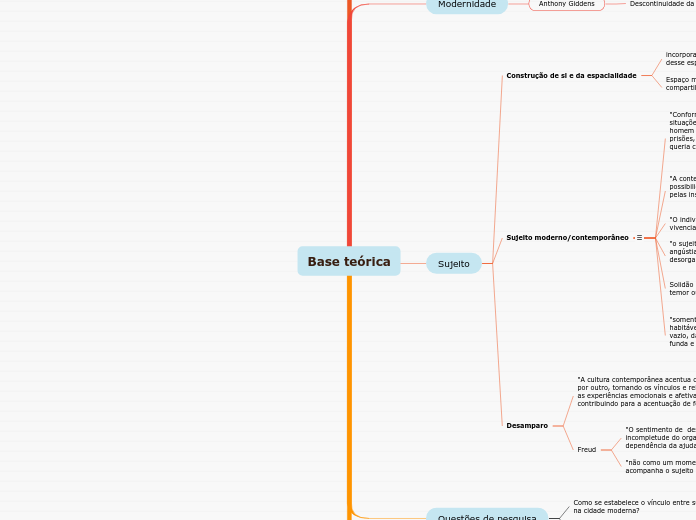jonka Lara Wayne 4 vuotta sitten
332
Base teórica

jonka Lara Wayne 4 vuotta sitten
332

Lisää tämän kaltaisia

To name your story, you have to think about the overall message and what you want your audience to understand from the story. Also, make it relevant and easy to remember.
Análise de conteúdo de relatos, crônicas sobre a cidade
Sugestões de livros
"Memória Porto Alegre: espaços e vivências"
"A Porto Alegre de Érico" 1935-1973
"Porto Alegre: memória escrita"
Análise de conteúdo de livros de ficção que retratem a relação entre sujeito e cidade moderna
Sugestões de livros por períodos no tópico da cidade
Estudos teóricos da evolução urbana
The ending of a story is essential. We all know that if the ending is weak, what happened before loses its importance. So make it unpredictable, but fair. A resolved ending answers all the questions and ties up any loose threads from the plot.
This is the moment when the main character surpasses the last obstacle and finally faces their greatest challenge.
The climax usually follows one of these patterns:
Type in your answer.
"não como um momento do funcionamento do psiquismo, mas como uma condição que acompanha o sujeito por toda a sua existência, como sendo um sentimento estruturante."
"O sentimento de desamparo, portanto, aparece já nas primeiras experiências da vida, como resultado da incompletude do organismo, de sua necessidade de realizar trocas com o mundo e da extrema dependência da ajuda de outros"
https://repositorio.unesp.br/bitstream/handle/11449/127030/ISSN1984-9044-2014-13-01-21-32.pdf?sequence=1&isAllowed=y
Pertencimento
Sentido
Vínculo
Coletividade
Psicologia do lugar
In the beginning of the story (or the exposition), you will need to introduce the setting and characters. You might also want to introduce the main conflict. This part of the story is important because it gives the reader necessary background information and maybe even a first insight into a character’s personality.
Characters are essential to a good story. Usually, the protagonist(s) is/are the most affected by the plot. Introduce a character by focusing on their actions, interests, and occupation, as the physical appearance doesn't make a difference in most cases.
Type in the name of your character.
Nova concepção de sujeito individual: - desprendimento da totalidade
Add other qualities/attributes of the character.
+ Dinamismo
What is your character's main goal?
Separação entre o tempo e o espaço
Which traits best describe the character's personality? Choose more if necessary:
Ritmo da mudança
Choose the type of your chacter:
The middle of the story is where you add layers of complications that will lead to the end. Reveal more about the character's journey. Did their personality go through changes? How did they overcome the challenges? And as you build up the story’s central conflict, make it more personal to that character. Also, from the middle act, you have to lead into the final act.
Your character(s) need(s) motivation in order to solve the challenge(s).
A partir de 1900 (Ascher)
Ampliação das possibilidades de escolhas (ex: transportes mais rápidos)
Metápoles
extensas, descontínuas, heterogêneas e multipolarizadas
Neourbanismo
1970-1990 (Des)caracterização
Secondary characters also might have motivs beacuse of which they may cross path with main character or which might trigger them to help the main character.
Maior contraste entre centro x periferia
periferia: isolamento territorial
desigualdades
A partir de 1980: chegada do liberalismo no Brasil
Viver na cidade = violência e criminalidade
Chegada dos Shoppingcenters --> centro: esvaizamento
POA: Dançar tango em Porto Alegre (Sergio Faraco)
A Hora da estrela (Clarice Lispector)
"Conto (não conto)" (Sérgio Santana)
Conto "Cenários" (Sérgio Santana)
Conto "Passeio noturno" (Ruben Fonseca)
Áreas vazias: condomínios horizontais
Bairros: crescimento veriticais
Fim dos bondes --> transportes públicos mais rápidos
Viadutos, perimetrais, elevadas e túneis
Escalas maiores: proporções gigantescas
1945-1970 (Trans)figuração
Secondary characters might also have motives that lead them to cross paths with the main character or which might trigger them to help the main character.
habitações coletivas
Grandes artérias radiais e avenidas perimetrais
Feição autoritária: prédios institucionais e nacionalismo
RJ: Feliz aniversário (Clarice Lispector)
RJ: Cidade Sitiada (Clarice Lispector)
1959: 1º plano diretor
1924-1945 A busca de uma modernidade urbana
Why does your character need to confront this challenge? What does he/she expect to accomplish by solving it?
See a few examples:
Alargamentos e aberturas de avenidas
Verticalização da área central
Redesenho da cidade em termos de uma modernidade
Livros
RJ: "A alma encantadora das ruas" (João do Rio)
POA: A ronda dos anjos sensuais (Reynaldo Moura)
POA: Cadeiras na calçada (Thelmo Vergara)
POA: Caminhos cruzados (Érico Veríssimo)
POA: Os Ratos (Dyonélio Machado)
Plano Geral de Melhoramentos
Each story has a main character and that character usually needs to solve a problem or challenge. The character's challenge is the one that creates tension throughout the story.
Type in any other challenges which other characters in the story need to face.
Menos espaços de convívio social
Verticalização
Escalas maiores
Menos escala humana
Estrutura da impessoalidade
Desenraizamento
Mais individualidade
Menos pertencimento
Maior população
Maior velocidade das mudanças
In most stories, there are 3 challenges. The number 3 is a mystical number symbolizing completeness. Try to come up with interesting challenges with which your character needs to struggle.
See a few examples below:
Órgão protetor contra o desamparo
Órgão produtor de subjetividade